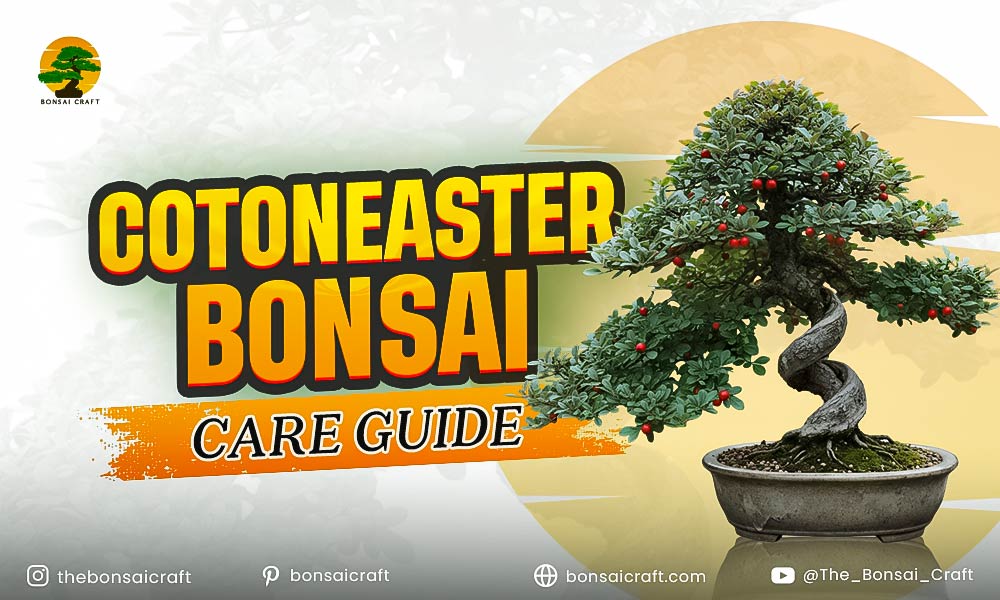
The Cotoneaster bonsai is a favorite among enthusiasts because of its small leaves, bright red berries, and adaptability to various bonsai styles. Whether you’re working with a classic bonsai Cotoneaster tree or experimenting with a Corokia Cotoneaster bonsai, this species offers incredible versatility for beginners and advanced hobbyists alike.
As someone who has cultivated and styled different Cotoneaster varieties for years, I’ll share detailed guidance on Cotoneaster bonsai care, seasonal needs, pruning, and styling techniques. This guide integrates both practical insights and expert knowledge so you can confidently maintain your tree throughout the year.
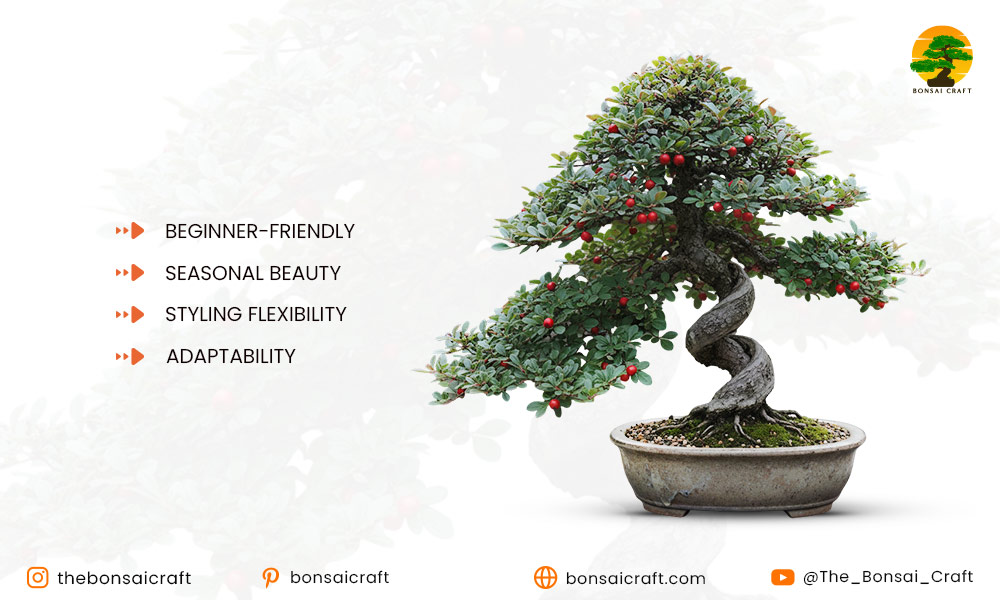
Why Choose a Cotoneaster Bonsai?
The cotoneaster tree is a member of the Rosaceae family with a whoopong 300 species. It is widely used in bonsai culture for its small, resilient leaves, as it can be shaped into cotoneaster bonsai styles like cascade, informal upright, or broom.
Key advantages:
- Beginner-friendly: For its hardiness, and the fact that it is forgiving, it is perfect for new bonsai growers.
- Seasonal beauty: In the Spring, tiny white flowers bloom, which are then followed by bright red berries.
- Styling flexibility: It can be easily trained and shaped to take multiple forms.
- Adaptability: With the right care, it can be indoor or outdoor.
How to Care for Cotoneaster Bonsai
What are the main care requirements for a Cotoneaster bonsai?
A Cotoneaster bonsai tree requires full sun, regular watering, well-draining soil, and seasonal pruning. Fertilize during the growing season, repot every 2–3 years, and protect the roots in winter. With consistent care, a bonsai Cotoneaster will flourish year-round.
Now, let’s dive deeper into each aspect.
Light Requirements
The Cotoneaster bonsai thrives best in full sun to partial shade.
- The Cotoneaster does best in full sun, but does equally well in partial shade.
- If growing indoors, it’s best to enhance sunlight exposure with grow lights.
- The more light provided, the more fruit and flowers the tree will produce.
Watering and Humidity
How often should you water Cotoneaster bonsai?
Water a Cotoneaster bonsai tree whenever the topsoil feels dry to the touch. The roots must not be allowed to sit in waterlogged soil, but the soil’s moisture should not be lost completely. A humidity tray can help maintain moisture, especially indoors..
Additional watering tips:
- When the bonsai is in a flowering or berry-producing state, boost the watering accordingly.
- In winter, the water should be decreased incrementally, but the roots must not completely dry.
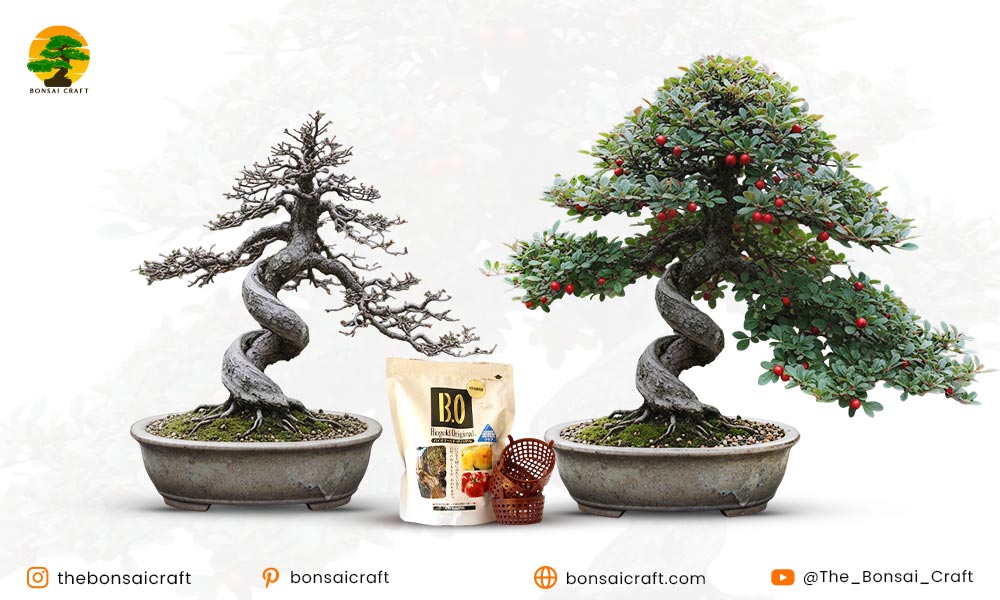
Soil and Fertilization
The Cotoneaster bonsai care routine requires nutrient-rich, free-draining soil.
- Soil for a Cotoneaster bonsai must be moist but well-drained. A mixture of Akadama, pumice, and lava rock is good to use, but it’s best to use a generic bonsai soil mixture for success with the least amount of effort.
- Fertilize every 2 weeks from spring to early autumn with balanced fertilizer.
- Use low-nitrogen feed during flowering for better blooms and berries.
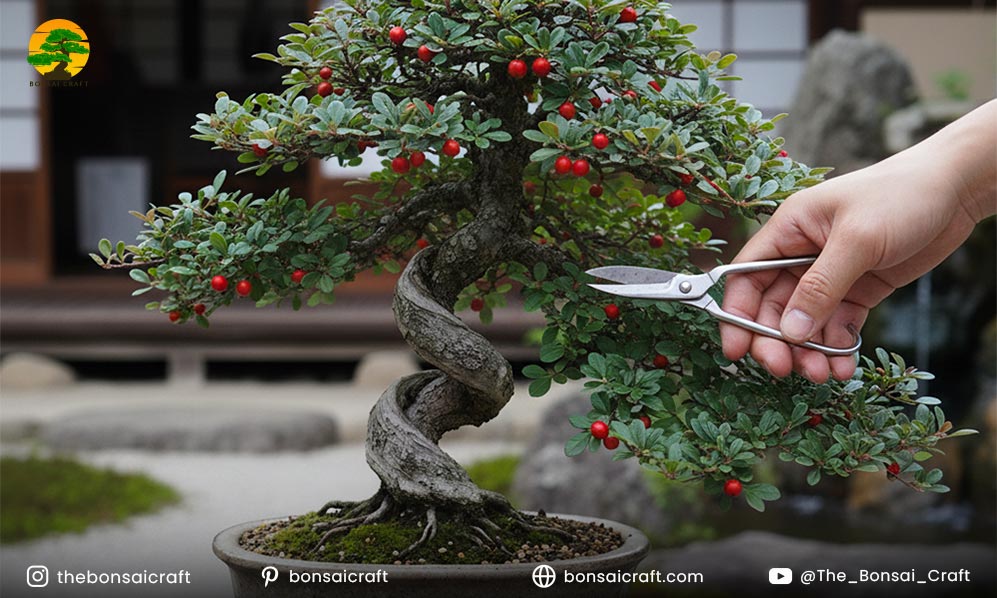
How to Prune Cotoneaster Bonsai
How do you prune a Cotoneaster bonsai?
To prune a Cotoneaster bonsai, trim new shoots to 2-3 leaves and wait for extension. Do the structural pruning during late winter to early spring, before the new growth. Routine trimming helps in upkeep and promotes smaller leaves.
Pruning notes:
- Flower buds develop on new growth, so avoid heavy pruning in spring.
- Use sharp bonsai scissors to prevent tearing.
- For advanced styling, combine pruning with wiring.
Cotoneaster Bonsai Styles
The bonsai Cotoneaster adapts well to many traditional bonsai styles:
- Informal upright – Natural, flowing structure.
- Cascade – Gracefully drooping beneath the pot.
- Broom style – Small leaves, fine branching.
- Root-over-rock – A structure full of resilience.
When to Repot Cotoneaster Bonsai
When is the best time to repot Cotoneaster bonsai?
The best time to repot Cotoneaster bonsai is early spring before new growth starts. Repot every 2–3 years to refresh soil and prune roots. Younger trees may need more frequent repotting, while mature bonsai can wait longer.
Steps for repotting:
- Remove the tree carefully and trim 20–30% of the roots.
- Place in fresh bonsai soil mix.
- Water thoroughly and keep in semi-shade for 1–2 weeks.
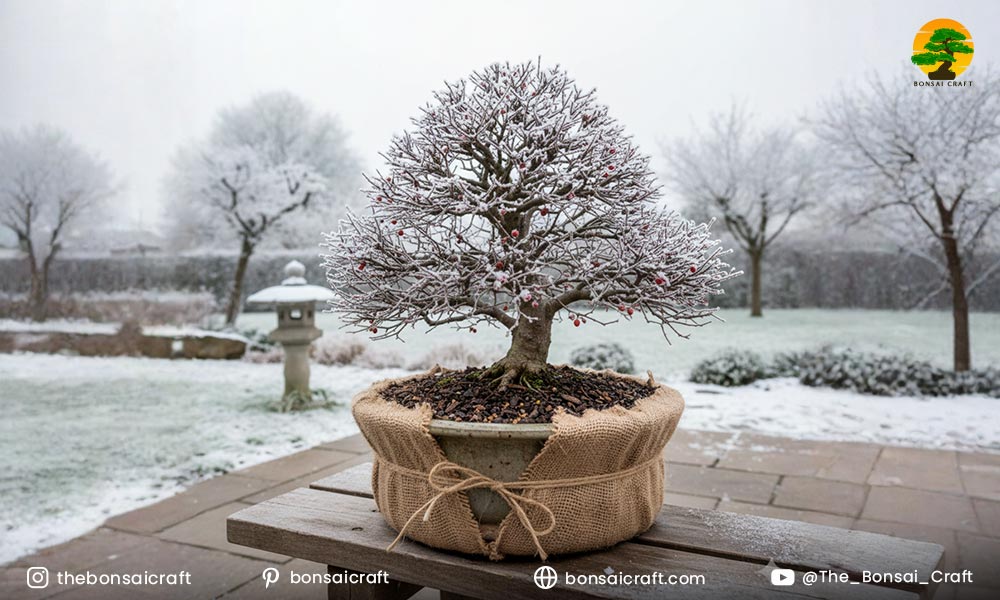
Cotoneaster Bonsai Winter Care
How do you care for Cotoneaster bonsai in winter?
For Cotoneaster bonsai winter care, protect the roots from frost by storing the bonsai in a cold frame, unheated greenhouse, or sheltered area. Water sparingly but don’t allow the soil to dry out completely.
Cold tolerance tips:
- Outdoor hardy types survive with root protection.
- If the area is overly cold, move them to a bright, cooler space
- Keep them out of direct air flow from heaters, vents or other rooms where the air is overly dry.
Corokia Cotoneaster Bonsai
This variety of Cotoneaster bonsai is especially popular for windswept or naturalistic styles, due to the twisted and zig-zag branches. It is also distinct from other species of Cotoneaster. Other than the distinct shape, its care is more or less the same than than that of other Cotoneaster bushes, though it requires more pruning that is more delicate than the other Cotoneaster species.
Common Problems in Cotoneaster Bonsai Care
Like all bonsai, the Cotoneaster bonsai tree faces some challenges:
- Pests: Watch for aphids, scale, and spider mites.
- Diseases: Root rot if overwatered; fire blight may occur in humid conditions.
- Leaf drop: Often due to underwatering or sudden temperature shifts.
Prevent issues with regular monitoring, balanced care, and seasonal adjustments.
How to Care for Cotoneaster Bonsai (Step-by-Step)
How do you care for Cotoneaster bonsai daily?
To care for a Cotoneaster bonsai tree daily, ensure it gets full sun, check soil moisture regularly, and prune as needed to maintain shape. Water when the soil surface is dry, fertilize during growth periods, and repot every few years. Provide winter protection in colder regions.
Cotoneaster Varieties for Bonsai
Some of the best Cotoneaster varieties for bonsai include:
- Cotoneaster horizontalis – Small leaves, excellent for cascade and upright styles.
- Cotoneaster microphyllus – Tiny leaves, perfect for shohin bonsai.
- Cotoneaster dammeri – Low-growing, great for root-over-rock styles.
- Corokia Cotoneaster – Distinctive zigzag branches.
Each variety has its own strengths, so choose one based on your styling goals.
Conclusion
The Cotoneaster bonsai is one of the most versatile and rewarding bonsai species. With its tiny flowers, vibrant berries, and adaptability to different styles, it appeals to both beginners and experts. From learning how to prune Cotoneaster bonsai to mastering Cotoneaster bonsai winter care, consistency is the key to long-term success.
Expert tip: Always align your bonsai care with seasonal needs. For beginners, starting with Cotoneaster horizontalis offers the easiest pathway to success. With patience and careful maintenance, your bonsai Cotoneaster will become a timeless piece of living art.
FAQs About Cotoneaster Bonsai Care
Is Cotoneaster a good tree for bonsai?
Yes, the Cotoneaster bonsai tree is excellent for bonsai because of its small leaves, resilience, and ability to thrive in various styles. It’s beginner-friendly and highly adaptable.
When should I repot Cotoneaster bonsai?
The best time to repot Cotoneaster bonsai is early spring before new growth begins. Repot every 2–3 years to refresh soil and prune roots for healthy growth.
How do I prune Cotoneaster bonsai?
For Cotoneaster bonsai pruning, trim new shoots back to 2–3 leaves and do structural pruning in late winter. This helps maintain the bonsai’s shape and encourages compact growth.
How do I care for Cotoneaster bonsai in winter?
For Cotoneaster bonsai winter care, protect roots from frost with mulch, cold frames, or by moving indoors. Water less frequently but ensure the soil does not dry out.
Which Cotoneaster varieties are best for bonsai?
Popular Cotoneaster varieties for bonsai include Cotoneaster horizontalis, Cotoneaster microphyllus, Cotoneaster dammeri, and Corokia Cotoneaster. Each offers unique styling opportunities.
